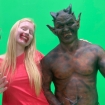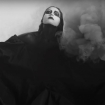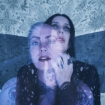Zev Deans is a director, editor and visual FX artist who has created music videos for Ghost, Mastodon, Gojira, Denzel Curry, HEALTH and more.
AI is scary. It is demonic. It is the beginning of the endtimes. The incomprehensible artistic horrors that emerge from its depths are matched only by the existential dread we humans feel when we are met with the impending probability of being replaced by a machine.
I'd say that's all pretty fucking metal, no?
As an artist caught in the middle of the most significant One-Track Trolley Problem of my creative life, I have deduced that my choice to engage with AI as an artform has made me simultaneously the person pulling the lever and the person tied to the tracks. Every time we use AI as a tool to make something, we are adding length to the rope that could eventually hang us. Again, metal as fuck.

There is no way to downplay the inherent threat AI poses to all walks of creative life. But as an artist working on the fringes of visual content since the late 1990s, I have seen many waves of change knock down established means of creative production and I learned that survival means never building a house on an island plagued with hurricanes. Both this and a desire to never be bored has led me to behave like a mad scientist and a scavenger when choosing the ways I make videos. So when DALL-E and Midjourney came along, I was curious. As somebody who came into creative maturity by making art by hand, it felt both exciting and unsettling to conjure up imagery from the mere input of a few carefully chosen words, like I had released a Djinn from a cursed lamp in a shadowy desert cave. (Slow heavy-metal music playing.)
But then I tried to use Stable Diffusion to generate video. And to my relief, I had no idea what the fuck I was doing. It was a code-based labyrinth of a process, a mountain of steps and equations. I was just a visual artist who got a D in Algebra and kept dying of Dysentery in Oregon Trail. I knew I was going to need help.
AI art, true AI video art, is hard to do. In addition to learning a new language, you must also develop your own unique workflow to achieve the results you want, as there's no precedent for anything. It is like taming a wild animal, if that animal was the writhing mass that Tetsuo becomes at the end of AKIRA.
Working with A.L.N. on our second MIZMOR video together, I had to top myself and go beyond the simple 2D animation style of my video for "Wit's End," and find an affordable way to do something spectacular. Both he and I have a lifelong love of the works of Zdzisław Beksiński, and I knew I wanted to find a way to bring his paintings to life. I traveled to Oregon with my frequent collaborator Brendan McGowan, and we spent two days working with A.L.N. and Emma Ruth Rundle to film the narrative footage on-location at a family farm and a public park in ALN's hometown of Salem. ALN's story follows his struggle with distraction and ideation, personified by a sort of Shadow Self. We determined that this creature would be a Beksinskian entity spewing gnarly yarn-like roots in an attempt to lure and ensnare its victim.

Enter the AI team of Adam Espino and Wolf Tijuana. Adam was a visual artist who worked as an illustrator and graphic artist until he flipped a car over and lost the use of his dominant hand. Met with the sudden inability to draw, he found a way to continue being an artist by learning AI. He met Wolf by joining her band (also called Wolf Tijuana) and they started making videos for themselves and others. I saw this on IG and knew I had to work with them.

Upon returning home, I started developing a remote workflow with Adam and Tijuana as we ventured into the unknown, trying to figure out how to merge AI video with live action footage. Taking many shots in the dark, we finally settled on a form of collage, where I would build layers and layers of found footage shaped to the needs of the shot, and then they would run the collage layers through AI enough times for us to find what we were looking for.

The full immersion into AI occurs around the seven-minute mark, a final decent into the protagonist's mind before a return to consciousness. This is the portion of the project that gave me chills. A lot of work went into the creation of that imagery, but so much of it seemed to emerge out of thin air. Only then did I start to comprehend just how big a threat this technology was to the livelihood of so many people. As I stared into the abyss, I thought to myself: "At least I'm getting my kicks before the whole shithouse goes up in flames…"

Mizmor's new album, Prosaic, is due July 21st via Profound Lore and available for pre-order now.











